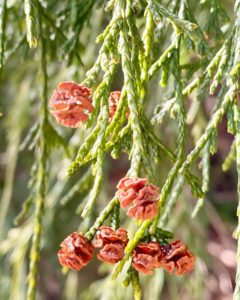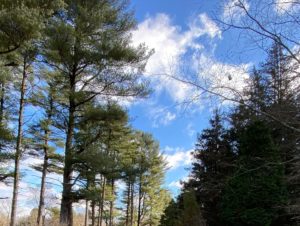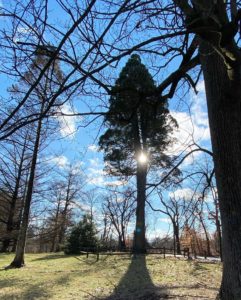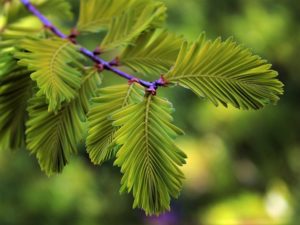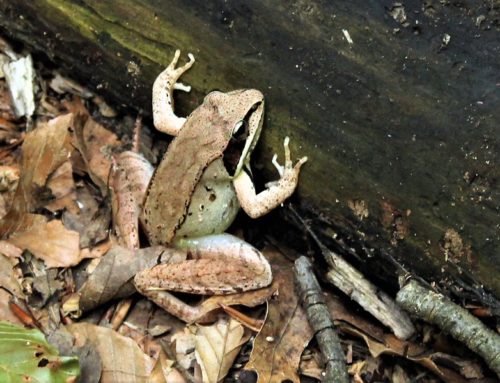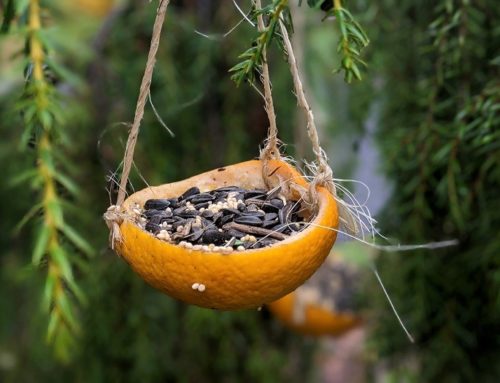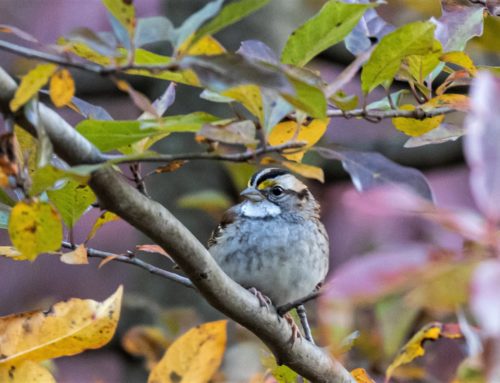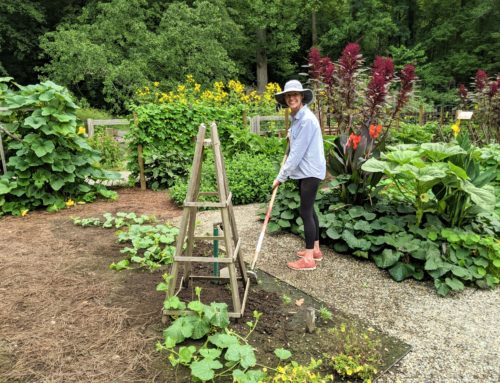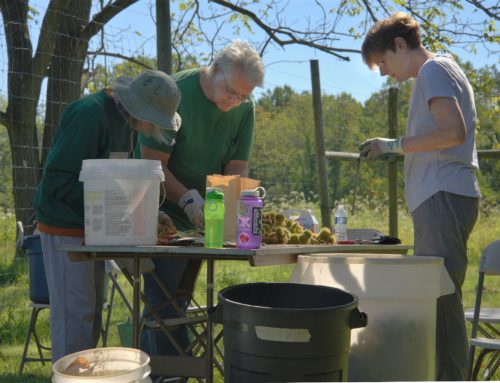Across Rocky Run, high up on a plateau overlooking the Old Arb, lies an area of Tyler we call the Pinetum. The Pinetum is a living museum of plants — home to pines, spruces, hemlocks, firs, cedars, false cypresses, and larches – all conifers, or cone-bearing species. While the formal definition of Pinetum refers to specimens of trees belonging to the Pinaceae family, the Tyler Pinetum included representatives from Cupressaceae, which includes junipers and redwoods.
It is 25 plus acres of regal evergreen (and non-evergreen) conifers, sweeping views, wide-open sky, and meadows. Walking through the landscape gives you a sense of space and scale. There’s an openness to it — a majesty and wildness to the trees that makes you take a deep breath, look and pause, especially in winter, when the evergreen plants of the collection shine.
The landscape feels timeless, as though it has been part of Tyler since the beginning, although it is only about 70 years old. The general plan for the Pinetum began in 1949 with the mapping of the trails, just three years after Tyler opened its doors as an Arboretum. The next few years saw the removal of the tulip trees (Liriodendron tulipifera) and ash trees (Fraxinus spp) that had overgrown the area. In the early 1950s, Gertrude Wister made the first detailed design plans. Gertrude was a graduate of the University of Wisconsin with a degree in Horticulture. She worked on a number of the early plantings at Tyler, including the bulb planting on the slope behind Lachford. Years later, in 1960, Gertrude would marry John C. Wister, Tyler’s first Executive Director, and eventually serve as Tyler’s acting director. You can learn more about the important role she played in Honoring Gertrude Wister on our blog.
Planting began in 1953, with small seedlings from Scott Arboretum (formerly Scott Foundation), Morris Arboretum, Alanwolds, Meehan, and Kingsville Nurseries. These seedlings were planted in the tree nursery at Tyler to be grown until they could be planted out in the Pinetum. The same problems that plague gardeners today threatened these trees in their early life. Dr. Wister recorded significant losses until the nursery could be fenced in to protect the seedlings from that most dangerous of garden visitors – the rabbit.
When the seedlings became saplings, they were transplanted to the Pinetum. Over the next five years, other young conifers from the Worton Arboretum, National Arboretum, Tayler Arboretum, and Verkade’s Nursery joined them. Many of these early trees remain, — the momi and nikko firs, the mighty atlas cedars, the Japanese and Austrian pines. Gertrude’s design followed the Rehder Manual of Cultivated Trees, and she carefully planned the plantings to showcase the beauty of these conifers. One specimen of each pine species was planted as a stand-alone tree so that visitors could observe and appreciate its growth habit. Another grouping of three to five specimens was planted to showcase how a mass planting would appear in the landscape.
The coming years were hard on these young trees, as they suffered damage from deer rubbing the velvet off their antlers and sawflies destroying half a dozen pine species. By the time the landscape passed through these early challenges, the Pinetum was home to nearly 200 trees, with over 50 species of the following genera: Abies, Cedrus, Chamaecyparis, Cryptomeria, Juniperus, Larix, Metasequoia, Picea, Pinus, Pseudolarix, Pseudotsuga, Sciadopitys, Sequoia, Taxodium, Thuja, and Tsuga.
The specimen trees in the Pinetum are more than 70 years old now. Gertrude and John Wister carefully selected conifers that would survive well in our area, and they have grown into a landscape that does precisely what Gertrude intended. The Pinetum is a place to connect with the splendor and importance of these trees. But why? Why devote so much space to this group of plants?
The answer to that question extends back to the planet’s earliest history and far, far into its future. Conifers, a subset of gymnosperms, date back to approximately 310 million years ago in the fossil record. For context, dinosaurs appeared in the fossil record about 240 million years ago. Ginkgo trees appeared about 40 million years after that. And angiosperms – the flowering plants we know and love – didn’t arrive on the scene until 145 million years ago, at which point conifers had been growing and evolving for 165 million years. Conifers are wind-pollinated and bear cones to disperse the next generation of trees. They can grow in various environments, including the Arctic Circle, and are among the oldest living individual plants on the earth. For instance, the oldest bristlecone pine (Pinus longaeva) is more than 5,000 years old. Conifers range in size from the towering coastal redwoods (Sequoia sempervirens), which can grow up to 361 feet tall, to the diminutive lodgepole pine (Pinus contorta), which can reach maturity at less than a foot tall. A collection like the Tyler Pinetum provides a window into this fascinating plant group that has endured so much, both in terms of time and conditions.
Dr. Wister and Gertrude Wister wanted a living history of conifers and to bring beauty and interest to a part of the property that was relatively flat. If you follow the path up to the Scenic Loop, where the Pinetum is located, you’ll walk on a relatively level plateau. At the time of planting, conifers were very much in vogue in the botanical world, and the open views and flat terrain made it the perfect place to showcase these beautiful plants. So let’s take a moment to meet one of the most famous specimens in the Tyler Arboretum PInetum.
Perhaps the most majestic tree you’ll see as you stroll the Scenic Loop is the Painter Sequoia (Sequoiadendron giganteum). In their native range, these massive trees can reach 311 feet tall with an average of 200 to 275 feet. The Painter Sequoia is the Pennsylvania State Champion at 103 feet. Sequoias are native to the Sierra Nevada mountains in central California, and those planted here on the East Coast are stressed by local conditions and generally only reach about 40-60 feet. That makes the Painter Sequoia one for the record books!
Unlike many of the other conifers in the collection, The Painter Sequoia was not planted in the early 1950s but somewhere in the late 1850s, fully a century earlier. It may be the most dramatic specimen in the Pinetum and likely the oldest, but it is by no means the only unique tree that grows there. Atlas cedars (Cedrus atlantica), table mountain pines (Pinus pungens), and dawn redwoods (Metasequoia glyptostroboides) all make their home in this beautiful landscape. A walk around the Scenic Loop will take visitors to see and enjoy these magnificent trees.
Living plant collections are an opportunity to see many different varieties of plants — in this case, across different species and genera — in one location. A plant collection is a place where you can see plants from around the world growing next to each other and just a few miles from your own backyard. Collections provide an opportunity to practice scientific studies and observe how different species adapt to changing conditions. A plant collection hosts a repository of genetics, where seeds can be collected and cuttings taken to preserve threatened, endangered, or biologically extinct species in the wild.
So, what’s next? Plant collections seldom remain static, and the Pinetum at Tyler has already begun to change. According to our Director of Horticulture, Mike Karkowski, “Our cedar of Lebanon, some of our spruces, and some of the firs are struggling with the change in climate.”
What we see in Tyler’s Pinetum echoes what the USDA has observed in our area and is reported in the document Mid-Atlantic Forest Ecosystem Vulnerability Assessment and Synthesis: A Report from the Mid-Atlantic Climate Change Response Framework Project. Locally, low and high temperatures have climbed, and average rainfall has increased by about 3.2 inches per year. And the tree species that can survive in Southeastern Pennsylvania are changing as a result. Balsam fir, black spruce, jack pine, northern white cedar, red pine, red spruce, tamarack, and white spruce are all projected to decline significantly in our area as temperatures increase. That means fewer seedlings of these species can germinate and grow in the forest, and existing trees will face increasing stress and lower survival rates. Slowly but surely, these species will diminish in our landscape as their range moves north.
Other species will take their place. Red cedar, loblolly pine, and pond pine are all expected to increase in our area as the local weather warms enough to suit these more southern species. We may even see brand new conifers, like longleaf pine and slash pine, move in.
We continue to add plant species to the Tyler Pinetum that we believe will thrive, even as conditions change and the climate warms. In 2021, staff and volunteers planted bald cypress (Taxodium distichum) ‘Lindsey’s Skward’, following Gertrude Wister’s 70-year-old design. We also planted dawn redwood (Metasequoia glyptostroboides) in an allee, which will provide an immersive stroll through these ancient trees. We continue to care for the existing specimens in the collection, most notably the Painter Sequoia, which our horticulture team irrigates in times of drought and treats fungal disease.
The Tyler Pinetum shows how conifer species are already shifting due to climate change. We will miss the soft wind-breaks of northern white cedar, the golden spires of tamaracks, and the stalwart jack pines, should these trees vanish from our area. But there is hope in the story as well — the cathedral effect of groupings of loblolly pines, the feathery pond pines, and the sturdy red cedar. These trees will grace our landscapes. In 100 years, they may very well be part of the character of our forests – and the Tyler Pinetum.
What will remain unchanged is what has always been a steady constant in our plants and plant collections. The Pinetum will adapt, as conditions around it alter – but it will remain a collection of beauty, and horticultural significance, precisely as the Wister’s intended.


